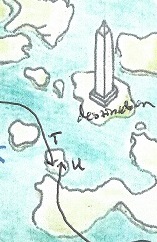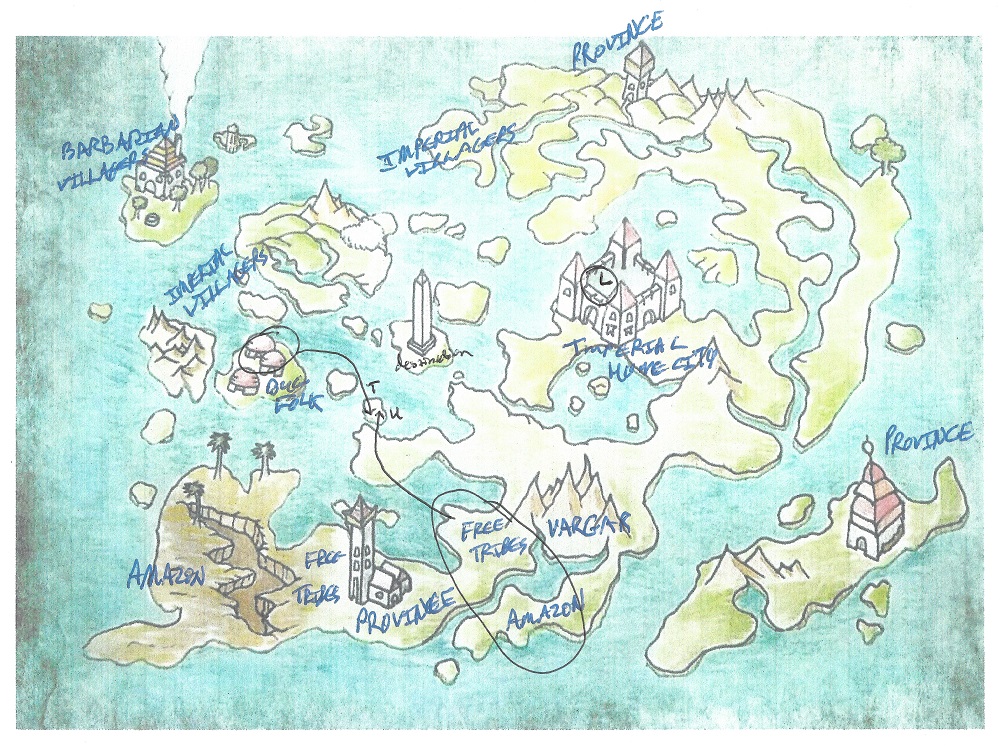 This is a bit of game design and a bit of an example for people interested in the “situations” topic I’ve been discussing lately. I asked patrons to make Whimsical Ways characters so I could try my hand at the instructions and notions I have for setting up situations for play, especially for the first session. The three contributors worked independently to make their characters, with no knowledge of one another or discussion. Helma made up Leonidas, a halfsnake artiste; Ross made up Tecmessa, an Amazon Tribes bug wizard; and Greg made up Ucmec, a Free Tribes bug wizard.
This is a bit of game design and a bit of an example for people interested in the “situations” topic I’ve been discussing lately. I asked patrons to make Whimsical Ways characters so I could try my hand at the instructions and notions I have for setting up situations for play, especially for the first session. The three contributors worked independently to make their characters, with no knowledge of one another or discussion. Helma made up Leonidas, a halfsnake artiste; Ross made up Tecmessa, an Amazon Tribes bug wizard; and Greg made up Ucmec, a Free Tribes bug wizard.
These three videos show what I have in mind to do with the plethora of information provided by character creation, and I hope it’s reasonably informative. I’ve attached the files you’ll need to see what I’m talking about. Certain things are specific to Whimsical Ways or to the batch of games which operate similarly, and others are of more general interest; I’m pretty sure it’s easy to tell the difference.
Other conversations have led me to realize that the following idea needs to be stated outright: It’s hard for people to separate “situation” from “GM’s prep.” I stress that we are talking about the fiction-in-action in play, shared imagined space that “moves” via system … thus who introduced what or has authority over what is entirely wide-open, even irrelevant to the basic concept.
Therefore, let’s not think of “the GM’s situation” and “the player-characters” in separated terms. We’re talking about the imagined whole: therefore, let’s say a player-character is loaded with backstory and motivations and all manner of complications, which means only that all that stuff is in the situation too, as much as the fortress or the mountain is, and in the same way.



3 responses to “Situation exercise”
Randomized vs assigned character features.
One initial observation I have on the process you're describing is that it touches and explores several subjects I've been particularly interested in for at least a couple years now, mainly the relationship between elements the players or the GM are free to choose and assign to characters at creations, and elements that are meant to be randomized from a table or matrix.
I'm not terribly interested in the most common manifestations such as "point buy vs roll 4d6 drop lowest in order" for ability points or randomizing height and weight, but rather this type of setting element, like "you've received an inheritance from a dead cousin".
Looking at how games are written, the presence of these randomized elements, their coherence with the rest of the setting and mechanics and their capability to bring in something that will stay relevant through play and gently invite GM and players alike to follow an internally coherent narrative (created through play and not pre-scripted events) seems to me to be a very technical topic, with precise causes and effects that are probably harder to master than the more commonly discussed issues with numbers and probability.
I think these videos, along with other whimsical ways discussions, are an excellent display on how these features are a goldmine for creating situations for the designated GM.
I would probably like to see the players' perspective on this; historically I have experienced that while GMs rub their hands and deeply enjoy this type of "bouncy", randomized elements in character creations, many players have manifested resistence or a necessity for control, and even more often some level of ennui for the game's intrusion in their desire to create the perfect "backstory". A good number of people I regularly play with has frowned at the idea of having to randomize elements of their character.
Another potential subject is how to maintain the momentum that these features provide past the initial situation. Using this type of feature I've often had results where we had an initial situation that was explosive and exciting but once the situation itself was exausted (often in asimmetrical ways for the various different players, given that this type of preparation rarely has led me to having a "quest" to place in front of the players), we felt like play potential was either exausted (and thus the game would end) or shifted towards more traditional momentum ("now that we know these characters, we can go dungeon crawling").
I think you’ve seen this:
I think you've seen this: Design Curriculum 2: Structure, where I introduccd a device I've used for a while in consulting (attached to that post). For the past year I've been including a revised version in my Introduction to Design course. It is a chart regarding starting information, not resolution or any events in play, and how it is determined.
One of my points is that we're not talking only about randomization and other means of determination as such, but instead we should work from the chart, and the next step is the order of determination, as procedure. So the taxonomy of the chart is only a starting point to understand the actual procedure. In that video, I talk a lot about Legendary Lives, not because it's the only game with randomized features and lifepaths – obviously those were in place immediately in the activity's early designs – but because it stands well above most games in getting the order right (for itself), and many with these methods do not.
You mentioned a "goldmine for the GM," and I suggest you may have it backwards, or at least, not complete. I think the real point is energy and inspiration for the person making the character. Contrary to current fashions in design, I think the common tactic of having everyone make things up about the situation in an alleged no-GM democratic way is not successful. But doing it the way I've shown in the video is successful.
That's not the whole picture. Trollbabe also demonstrates this observable surge in player investment and proactivity, but it is built on exactly the opposite principle: there's no random element to design and there's no connection between situation preparation and character features. Also, I've observed the same surge in many, many instances of play for which I passed out pregenerated characters, so the simple notion that "if I make it up, then I care more" is obviously mistaken.
So the real issue is the energy and proactivity, and clearly there are many ways to get there … but far more ways to fail, and fail badly, and fail consistently to the point that we call tolerating this failure to be the mark of an experienced role-player.
In this case, this method places the randomized elements of character creation in the right order with other means of determining starting information. It works really well – but our job now is to recognize for what and also to recognize other orders and other means, as well as to identify failed states and how they happened.
You mentioned a “goldmine for
I fully agree on this point; I guess in my mind that player energy and their input is the goldmine, and I probably failed to convey that.
In this type of process the way the information bounces between the various actors at the table (players, GM, rules/charts/etc) creates a dialogue where ideas are processed at different moments by different people. The order in which this is done seems incredibly important to me, because that's where the human element can become critical – the random table gives me a factoid or input that I do need to tailor around my own character or use to shape my character, and this is still a creative process. A better creative process than (as you said) the usual, modern-design workshopping where people simply makes up what they want or care about, with little to no interaction or limitation and with a solid dose of pre-programming.
I think the value of the process is even easier to underline if contrasted to, say, someone presenting the DM with a complicated backstory that the DM has then to accomodate for. Both timing and the absence of limitations feel critical here: even if the DM waits until everyone has their backstories ready he will still have to deal with a flow of informations that is in no way restricted or limited to the useful.
That's why I say I think in this aspect game design is critical: either by clearly stating what is expected or at least important in preparation, or by providing tools that guide those information towards usability. A functional game may completely separate player preparation (character creation) and GM preparation but it will instruct both about what they prepare in a way that avoids them clashing at the table in unwelcome ways. Sticking to your examples, I would say Trollbabe does exactly this, taking care of telling everyone what is important and not tempting them to bring unnecessary elements into play; if we contrast this with a strong traditon of D&D play – expecially the AD&D 2nd edition to 3E era – where backstory/background elements are unregolamented and unguided leading to people bringing in backstory elements and workshopping/pre-programming play in a way that, to me, isn't terribly dissimilar to what people does with Dungeon World, simply replacing putting pressure on the DM with having the book say that you can do it.
The result being that either those elements are incoherent with GM prep or with the game's themes and goal, and thus left unexplored and unused to everyone's frustration (alternatively, forced into play through social pressure by the player) or way too conveniently placed so that they would emerge and develop exactly as envisioned (this is what I refer to when I say I saw play exaust itself in session 0 so many times).
So I guess the reason I like these features (the general idea of the games' rules, including setting/color guidance, needing to be interacted with by all during preparation and returning information that needs to be further processed) is that it allows for that energy and proactivity to be guided and not to go wasted. It also is a damn fun creative process, much, much more fun than sitting down to write backstory for a character or situation with no limitation in place is, at least for me. I think preparation (player and GM alike) is already "play" and having bounce in it makes it better.